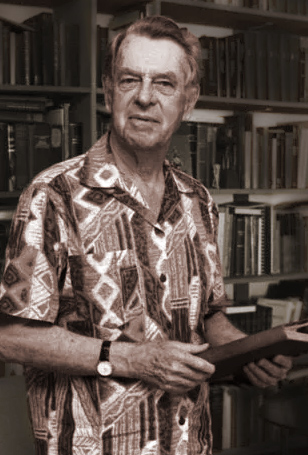 In the last blog, I spoke of the chakras as felt-sense, as a language to describe universal body-centered experience. Here I’d like to talk about chakras instead, as stages of spiritual transformation. Well, I’m actually going to invoke the spirit of the late, great Joseph Campbell (1904-1987) to do that for me. He is, in essence, the father of comparative world mythologies.
In the last blog, I spoke of the chakras as felt-sense, as a language to describe universal body-centered experience. Here I’d like to talk about chakras instead, as stages of spiritual transformation. Well, I’m actually going to invoke the spirit of the late, great Joseph Campbell (1904-1987) to do that for me. He is, in essence, the father of comparative world mythologies.
Campbell defined mythology as “an organization of symbolic images and narratives, metaphoric of the possibilities of human experience and fulfillment in a given culture at a given time.” Yes, that’s a mouthful, but simplified, he’s saying myths use words and images to convey all the possibilities of human experience through the language of metaphor: ie. John is a dog. He further, often spoke and wrote about the critical difference between the denotation and connotation of the metaphor. The denotation is the ACTUAL words on the page, while the connotation is the deeper meaning or understanding being implied, what those words or images are pointing to. John is not physically a canine, but I’ve packed a lot of implied meaning into just a few words.
This audio recording and transcript is a brief excerpt from a conference that he and author, Jean Houston did in California in 1985.1 I listened to those ten tapes countless times back then and recently digitized them for posterity. With his characteristic whit, Joseph Campbell does a masterful job of making the ideas and imagery of the 7 Chakras easily relatable. Here he looks at them as developmental stages of human spiritual evolution.
- Muladhara, The Root Base
- Swadishtana, Her Favorite Resort
- Manipura, City of the Shining Jewel
- Anahata, Not Hit
- Vishuddha, Realm of Purgation
- Ajana, Tisra Til, Eye Center
- Sahasrara, Thousand Petaled Lotus
Joseph Campbell
It’s my notion that the most precious gift that India has given us is this of the psychological stages of spiritual transformation, that is symbolically represented in what they call the lotuses or wheels, padmas or chakras of the ascending energy of the spiritual life as it mounts from the very root of the body, through the stages to the crown of the head.
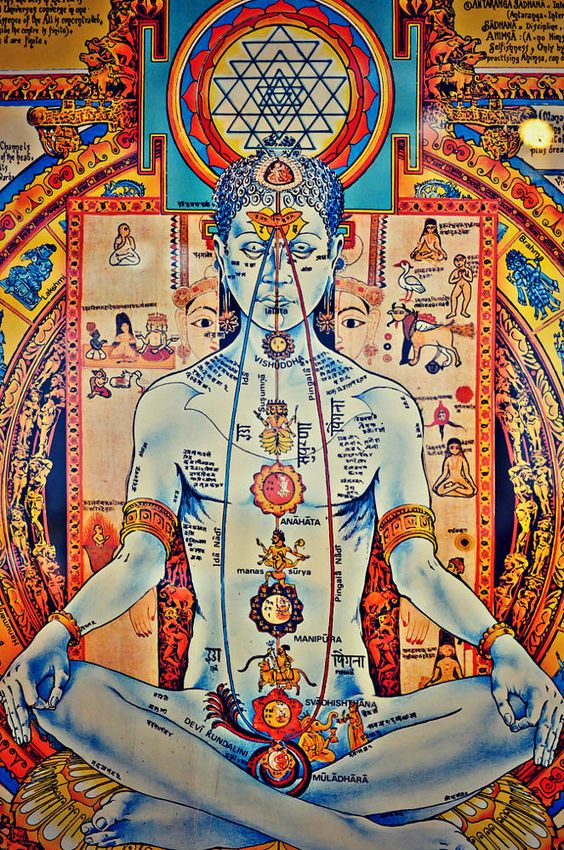 Now, these are classified as seven stages, and three of them are established in the pelvic area. These are stages of psychological realization and fulfillment, let’s say, that we share with the animals. Each of the stages is primarily represented by some organic function, one of the organic functions, the prime function, I think, the one without which no one exists at all is the eating function, that of the alimentary tract. And the lowest of the centers, is centered at the rectum or the anus, and is associated with just clinging to life, hanging on to life. There’s no particular joy here, there is just the kind of avidity to ‘be’.
Now, these are classified as seven stages, and three of them are established in the pelvic area. These are stages of psychological realization and fulfillment, let’s say, that we share with the animals. Each of the stages is primarily represented by some organic function, one of the organic functions, the prime function, I think, the one without which no one exists at all is the eating function, that of the alimentary tract. And the lowest of the centers, is centered at the rectum or the anus, and is associated with just clinging to life, hanging on to life. There’s no particular joy here, there is just the kind of avidity to ‘be’.
The image that comes in my mind here is dragons. The image of the energy that is used is of a serpent, is called a serpent power, Kundalini. The serpent is a very important mythological symbol in practically every culture. And what it symbolizes is the power of life in the field of time to throw off death. The serpent sheds its skin to be, as it were, born again.
There is an important myth, from about 1750 BCE, the myth of Gilgamesh. And Gilgamesh dove to the bottom of the cosmic sea, to get the elixir, the plant of immortal life, so that he should be immortal. And when he finally came up with the plant and rode ashore, he was so tired, that he didn’t eat the plant at that time, he thought he’d take a rest, and then eat it. And while he was asleep, the serpent ate the plant. That’s why the serpent can shed its skin to be born again.
The moon sheds its shadow to be born again, and the moon and the serpent are equivalent symbols: one celestial, the other terrestrial. The serpent is bound to life, bound to the earth. And so as I say, it’s a elegant symbol for this power of life, in the field of time, in the field of phenomenality, to throw off death.
Another thing about the serpent, its fluid, watery movement, and its being at home in swamps and in the water, is matched by this ever flashing tongue. And that fire is the fire of fertility which informs all water. Water is the fertilizing agent and that’s the fire in the water. The serpent is one of these things.
 Another thing about the serpent is the image of the Uroboric serpent biting its own tail. This is a symbol of life, living on itself. Life living on life. There’s a wonderful little story to this effect from India of the life living on life, which I think some of you have heard me tell. A demon came to Shiva one day and demanded that Shiva yield to the demon Shiva’s, wife, Parvati or Uma. And Shiva was so insulted by this request that he thought he would do the drastic thing and he just opened his third eye and a lightning flash came out and smash like that, great dust clouds flew in all directions. When the dust had cleared there was standing a second demon with a lion face and waving hair out to the four directions who had been created to eat up demon number one.
Another thing about the serpent is the image of the Uroboric serpent biting its own tail. This is a symbol of life, living on itself. Life living on life. There’s a wonderful little story to this effect from India of the life living on life, which I think some of you have heard me tell. A demon came to Shiva one day and demanded that Shiva yield to the demon Shiva’s, wife, Parvati or Uma. And Shiva was so insulted by this request that he thought he would do the drastic thing and he just opened his third eye and a lightning flash came out and smash like that, great dust clouds flew in all directions. When the dust had cleared there was standing a second demon with a lion face and waving hair out to the four directions who had been created to eat up demon number one.
Well, when you are in such as position as that of demon number one, there’s only one thing you can do. And that’s to throw yourself on the mercy of God. And so demon number one threw himself on the mercy of Shiva.
Well, they’re kind of ground rules in this God game. And when someone throws himself on your mercy you grant it. So Shiva granted the mercy that this demon should not eat demon number one.
And then demon number two said, “Yeah, but what about me, I’m hungry, and you have created me as hunger.” This thing is this prime driver of hunger. And so he said, “I look around but what am I gonna eat?” Shiva had a great idea. He said, “Why don’t eat yourself.” So the demon starts on his toes, he comes chopping up the line. And finally there’s nothing left but his face.
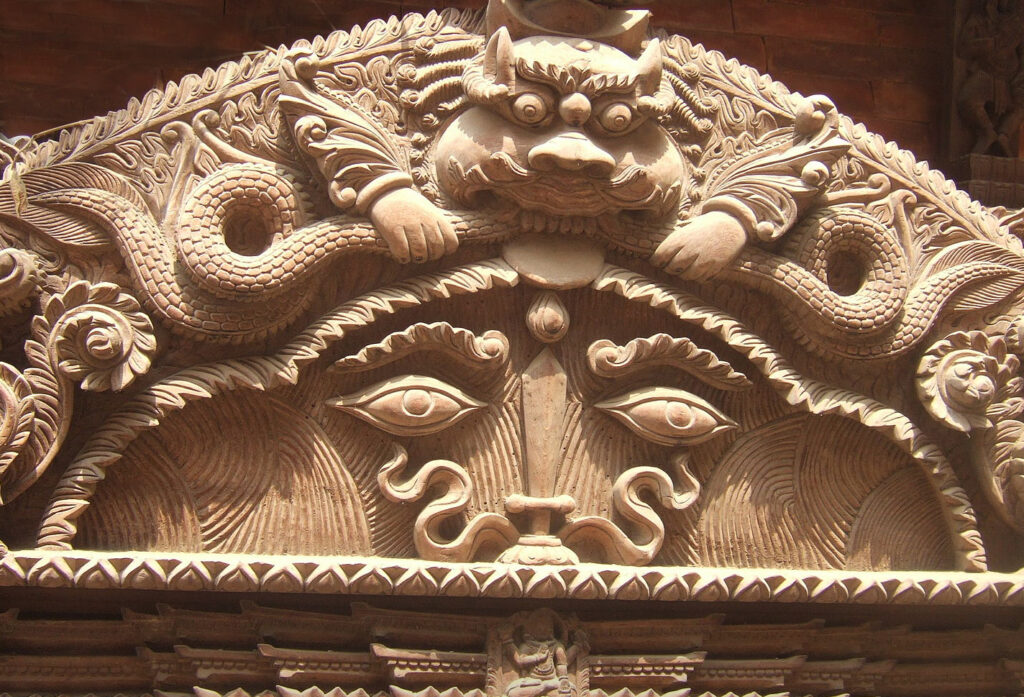 And Shiva was so delighted by this, because it absolutely epitomized the whole sense of life, — life is eating life, eating itself all the time. He said, “You’re marvelous! I’m gonna call you Kirtimukha, Face of Glory. And on my shrines, this will be above the entrance.” Here’s a very important statement, “No one who will not bow to you, is worthy to come to me.”
And Shiva was so delighted by this, because it absolutely epitomized the whole sense of life, — life is eating life, eating itself all the time. He said, “You’re marvelous! I’m gonna call you Kirtimukha, Face of Glory. And on my shrines, this will be above the entrance.” Here’s a very important statement, “No one who will not bow to you, is worthy to come to me.”
So until you can say to life, that yay, you know, to this nature of life, you can’t pass on to spiritual, transcendent realizations. And so the saying no to this, saying no to that quality of life is the blockage, you might say, to any further process.
So, this 1st Chakra represents that principle of just, avidity, hanging on. But if that’s all you’ve got, then the energies are not coming up higher. Now, the idea of sublimation here is not the idea that you get from Freud, that sexual drive is THE drive and everything else is the sublimation of that, this drive at the base here is simply the root out of which the spiritual life is to grow like a tree. An oak tree is not the sublimation of an acorn. It’s the maturation of the acorn. And so the goal now is to release the energies from this bondage.
And so I think of people living on this 1st Chakra level without any joy in life, without any real delight just hanging on as dragons, and we call such people creeps, they have no joy of life, and no sense of life. They just glue on to you, and they’re trying to suck it out of you; the sense of what they should be, what they should do, and all of that.
Jean Houston
It’s the Yiddish archetype of the nebbish, the nebbish is someone when he enters the room, you feel like somebody’s left. He’s pure 1st Chakra.
Joseph Campbell
(Campbell and audience laugh). Well, that’s better than I ever thought of it!
Jean Houston
No energy but tragedy.
Joseph Campbell
Well, you have this on the animal level. I mean, that’s the prime thing of life, as I say, a serpent is a traveling esophagus, also. (laughter). And one terrible thing about the serpent is when it’s coming at you, for minute, there’s no discussion. I mean, that’s all it is!
 So we come down to the next level, which is the genital level. And there you have, basically Freudian psychology of Eros, the drive of sex as the dominant of life. And then, of course, there is delight. I mean, it’s wonderful. ‘I’m in love again, you know, and the birds are singing’, all that kind of thing. People say love is blind. Because anyone can see that the person you’ve fallen in love with, I mean, if you’ve really fallen in love, is not what you think. You have attributed sort of divine powers to some little stupid… and that doesn’t matter. As far as your life is concerned it doesn’t matter how stupid that thing is. Your life is illuminated. And that’s because 2nd Chakra is working.
So we come down to the next level, which is the genital level. And there you have, basically Freudian psychology of Eros, the drive of sex as the dominant of life. And then, of course, there is delight. I mean, it’s wonderful. ‘I’m in love again, you know, and the birds are singing’, all that kind of thing. People say love is blind. Because anyone can see that the person you’ve fallen in love with, I mean, if you’ve really fallen in love, is not what you think. You have attributed sort of divine powers to some little stupid… and that doesn’t matter. As far as your life is concerned it doesn’t matter how stupid that thing is. Your life is illuminated. And that’s because 2nd Chakra is working.
The next stage — and what I’m going to do is illustrate this in a little while, — but I want to give you the story first. The next stage, by the way, all symbology now, has sexual reference. It is true that, that as Dr. Freud says, “everything round suggests the female, everything long suggests the male.”, and you can go on and be a Freudian… it’s the easiest thing in the world to see these simple associations.
I’ve just come, by the way, from a big conference of Freudian analysts, and well, (laughter) …of all things, the subject was love. And most of them had patients that were in real trouble! And when I came out, I thought, Well, asking a psychoanalyst about the role of love in life, and how to find it in your life, and how to have it shape your life, is like asking a garbage collector how to prepare a meal. It’s at the wrong end of the line.
Jean Houston
The problem also is that so much of that kind of Freudian psychoanalysis is truly the study of the id by the odd. (Laughter)
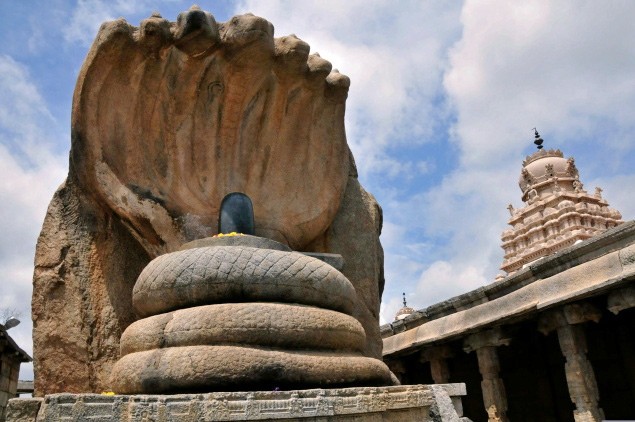
Joseph Campbell
Well, then the next stage of this rising, Kundalini means coiled up one, coiled up female serpent. There’s a point that some of you may be interested in, in India, the idea of Energy has female associations always. And I always understand that when I have a session with Jean Houston. The energy that you put forth is really illustrative of the quality of the Shakti, as it’s called, the energy.
Joyce uses that in Anna Livia Plurabelle, she is the energy evoker. The male just wants to be left alone. Listen… and then she goes twinkling by and says, ‘wouldn’t it be nice to start the world again’, and you think, ‘Oh God, it would’, and then it gets started. And so this, this evoker of the male energy. Well, sometimes the evoker can be surprised by how much energy is evoked!
And it’s interesting in China and in European thinking, the male is the aggressor, and the female, the receiving energy. What they’re talking about is, you might say, the physical aspect. But the psychological aspect, what evokes it, is out of the female. So, India works always on the psychological basis. And, and so this rising energy and it rises through all of the chakras is the female power, Shakti, Shakti, Maya Devi and that is what creates the world. Maya, the whole display of the energy in the field of time and space is the production of the Goddess.
The 3rd level is at the navel. It’s called Manipura, the City of the Shining Jewel, the 2nd level is called Swadishtana which means, Her Favorite Resort, and the 1st one is called Muladhara, the Root Base. At the level of the Shining Jewel, the energy is aggressive, this is the Adlerian psychology of the will to overpower. This, in a way, is a transformation of [Chakra] 1. One is the will to hang on. And now that in a relationship situation is the will to conquer and overcome.
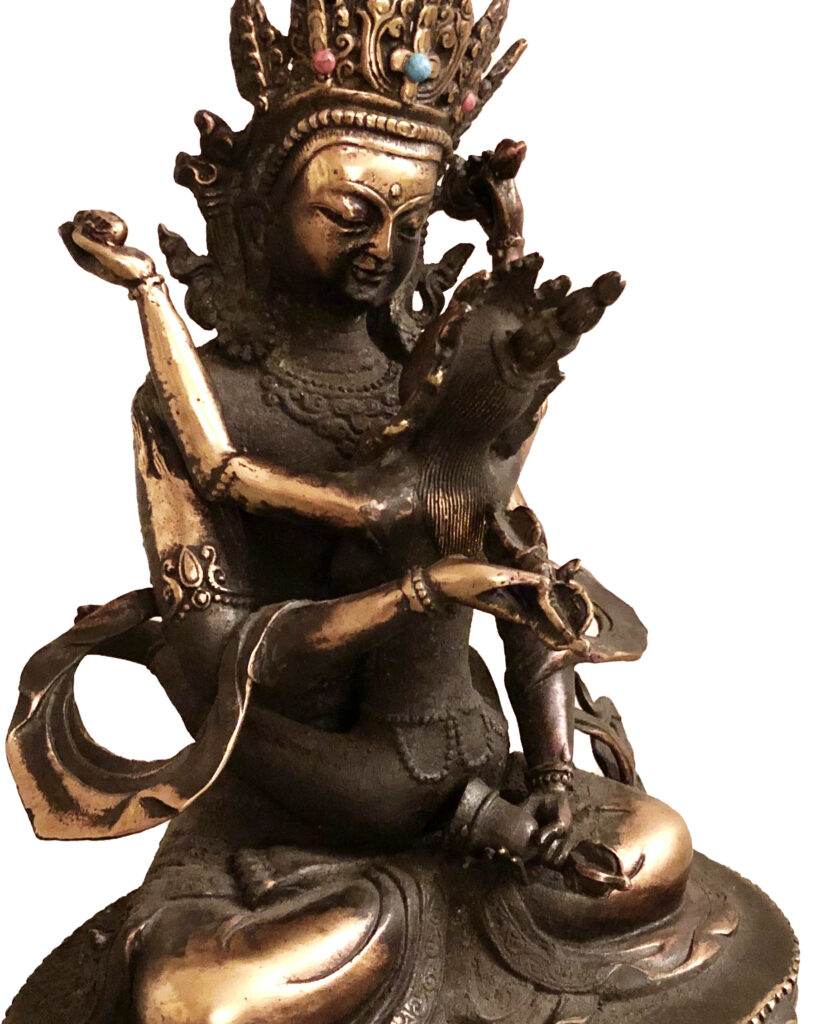 All of the signals here are transformed then into power relationships, and even love is an overcoming. I have had friends, male friends who thought they were lovers. But that’s not what they were. They were conquerors. And every woman was a challenge. I mean, they were so uncertain of themselves that every woman was a challenge, and this passion with respect to her was a self-reaffirming urge. That’s love as it’s called, on the 3rd level.
All of the signals here are transformed then into power relationships, and even love is an overcoming. I have had friends, male friends who thought they were lovers. But that’s not what they were. They were conquerors. And every woman was a challenge. I mean, they were so uncertain of themselves that every woman was a challenge, and this passion with respect to her was a self-reaffirming urge. That’s love as it’s called, on the 3rd level.
Now as I say, these three chakras, or centers or padmas, lotuses, are essentially in the pelvic area below the diaphragm. Next comes a very important, THE important area, for the human species between the diaphragm and the shoulder yoke. This is the realm of breath. This is the realm of the beat of the heart. This is the realm of the rhythm. And this is the realm of the 4th realization, which is of Compassion. It is the opening of the heart. And that compassion comes with the hearing of the sound of transcendence within all things. Or within that one thing which has opened your heart. The sound, of course, is Aum. I’ll be talking about a little more complicated. But the point I want to make now is, the psychoanalysts that I was with are reading everything on levels 1, 2, and 3. And I was there lecturing on the opening of the heart, I was talking about medieval courtly love. There was no understanding. I mean, there was no communication. And, the opening of the heart is the becoming human.
If the heart hasn’t opened, you may discipline a little human animal with rules, laws for civilized action. But once the heart is open, riles are not necessary. The idea of dharma, the idea of discipline, the idea of duty and all, is to fashion you into the shape of someone whose heart had opened. Do you understand what I’m saying? Otherwise, you’re not a human being, you’re not living in the society. Now, I’ve been thinking about this experience I just had on the plane down and all that sort of thing, (or up, I don’t know which direction I was going).
 And it just seems to me that an awful lot of what is going on with our youth today and the terrific explosion of crime. And then minor crimes like stealing books from the library, which goes on in every campus. I taught in a little campus, and suddenly books began not to be there. And only the other day in the public library, I put in a card, ‘can’t find it on the shelves’, I put in another card, the book comes, the pages I wanted were ripped out. That didn’t used to be! And I think it’s partly because, let me say, the disciplines are operating on the levels 1, 2, and 3., and there is no evocation of the humanity. There is no evocation of anybody else being in the world, except this little animal. And so, It seems to me that until this awakening takes place, you are a human animal. That’s a pretty decent animal, but it’s still an animal. And this is the awakening of the heart, Chakra 4.
And it just seems to me that an awful lot of what is going on with our youth today and the terrific explosion of crime. And then minor crimes like stealing books from the library, which goes on in every campus. I taught in a little campus, and suddenly books began not to be there. And only the other day in the public library, I put in a card, ‘can’t find it on the shelves’, I put in another card, the book comes, the pages I wanted were ripped out. That didn’t used to be! And I think it’s partly because, let me say, the disciplines are operating on the levels 1, 2, and 3., and there is no evocation of the humanity. There is no evocation of anybody else being in the world, except this little animal. And so, It seems to me that until this awakening takes place, you are a human animal. That’s a pretty decent animal, but it’s still an animal. And this is the awakening of the heart, Chakra 4.
You will be interested to know that each of these chakras has a symbol. And the symbolic sign on this chakra is exactly the Star of David or Solomon Seal. That is where the two come together, the material experience and the realization of the spiritual ground. And the spiritual ground is the uniting ground, and the opening of the heart and so forth and so on.
Then, this is the place that’s called Anahata, Not Hit. And what that word means is the sound that is not made by any two things striking together. My voice is of the air on the laryngeal chords. All the sounds that we hear of things striking together or rubbing together. What would the sound be that is not made by two things striking together?. It is the sound of the energy, of which all things are manifestations. This we get in the atomic sciences now. There’s an energy there, E=MC2. This is the E of the M, which is antecedent to things, and that is the energy that is your life. And the hearing of that sound is the recognition of the energy. That’s what, I have artist friends; writers and musicians who say, unless you get the Buzazu with the buzz-buzz, you don’t have a work of art. Unless that somehow is coming through to you, you’re not working on the level of transcendence.
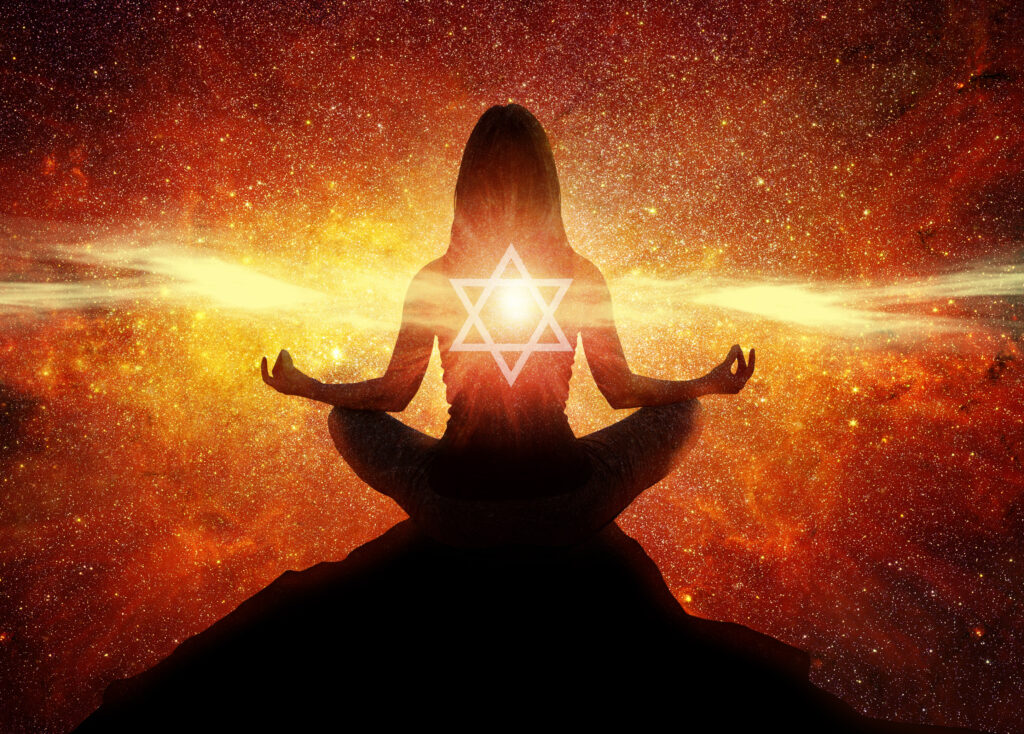 So it’s hearing that in everything, then you don’t have to grab anything because it’s there. Now the Freudians call this voyeurism and it’s regarded as pathological. But, I mean every advance beyond Chakra 2 is pathological. And as I say, you don’t get to be a human being until you’re a pathological animal. As Freud says, [or rather] as Nietzsche says, “Man is the sick animal”. There’s another thing [that] has come in that gives him a much more complicated and diffuse, diffused kind of life possibilities.
So it’s hearing that in everything, then you don’t have to grab anything because it’s there. Now the Freudians call this voyeurism and it’s regarded as pathological. But, I mean every advance beyond Chakra 2 is pathological. And as I say, you don’t get to be a human being until you’re a pathological animal. As Freud says, [or rather] as Nietzsche says, “Man is the sick animal”. There’s another thing [that] has come in that gives him a much more complicated and diffuse, diffused kind of life possibilities.
Well, now with this sound, comes the zeal to be close to it, really to unite with it, and to let that be the moving energy of your life, rather than the display of allures that move you into this, that, or another lifestyle. To be moved basically out of that. And in order to do that, you have to, as it were, cleanse your senses of their zeal for the sheer object. To see that object as a manifestation of the sound is very different than seeing that object as something you want to grab. That’s what I meant earlier when I spoke about the static position of the eye of art, you are looking right into the thing.
And I’m using a term of a wonderful German psychologist, now, Karlfried Graf Dürckheim, an old man about 90 years old. And he says, “You must make your life transparent to transcendence.” Your ego has pulled it over here, in this, that, and the other. And it doesn’t even know what the energies are, that are within it. Pull it together! that’s the goal. And once you’ve done that, the two centers are together; your center and the cosmic center, your ‘I’ and the world ‘I’, and you’ve made it.
 And so comes the business of discipline, to pull yourself together. That is of what is called the Chakra 5 or Vishuddha, the Clarifying, Purgation. Vishuddha means purgation, purgatory. Cleansing your consciousness of its fix[ation] on the mere phenomenal forms. And how do you do that? You do that by taking the energy of Chakra 3, the thrust to conquer, and turn it on yourself. This is called the ‘Turning About of the Shakti‘. And when you see those Buddhist and Hindu images of a deity embracing his Shakti it’s the Turning About of the Shakti, the joy of the energy is not in acquiring something out there or conquering something out there. It is in the identification of the self, of what you really are, that’s the highest and what else do you want. When people talk about finding their identity, that’s a very superficial word for this, this thing; of becoming identified with your identity, which can follow only [from] wiping out distracting and diluting aims, which are those of the three lower centers, and seeing through the aims of the three lowest that …well, we’ll come back to that at the end.
And so comes the business of discipline, to pull yourself together. That is of what is called the Chakra 5 or Vishuddha, the Clarifying, Purgation. Vishuddha means purgation, purgatory. Cleansing your consciousness of its fix[ation] on the mere phenomenal forms. And how do you do that? You do that by taking the energy of Chakra 3, the thrust to conquer, and turn it on yourself. This is called the ‘Turning About of the Shakti‘. And when you see those Buddhist and Hindu images of a deity embracing his Shakti it’s the Turning About of the Shakti, the joy of the energy is not in acquiring something out there or conquering something out there. It is in the identification of the self, of what you really are, that’s the highest and what else do you want. When people talk about finding their identity, that’s a very superficial word for this, this thing; of becoming identified with your identity, which can follow only [from] wiping out distracting and diluting aims, which are those of the three lower centers, and seeing through the aims of the three lowest that …well, we’ll come back to that at the end.
When the cleansing has taken place, you move up to this chakra here [Chakra 6]. And that’s when you see that image of God. That is a personification of the totality of the energies that informed the world. And it is an image that will be historically conditioned by your experiences. Any God that anybody can see in vision or think about in thought, is historically conditioned. It’s historically conditioned by your environment, altered by the capacity of your mind, and so forth and so on. The highest experience then here is of the fulfilled soul now confronting the God. That is the two centers together, your ‘I’ and the world ‘I’ are one …and yet it’s two.
So you’re still in the field of duality. Still in the field of two. God is there you’re here. Ramakrishna compares this to the situation of beholding the God with a pane of glass between. Thomas Aquinas himself says that in heaven before the beatific vision the soul beholds the vision but does not understand it. Yet the goal of the mystic is ultimate identity, realization of his identity with that.
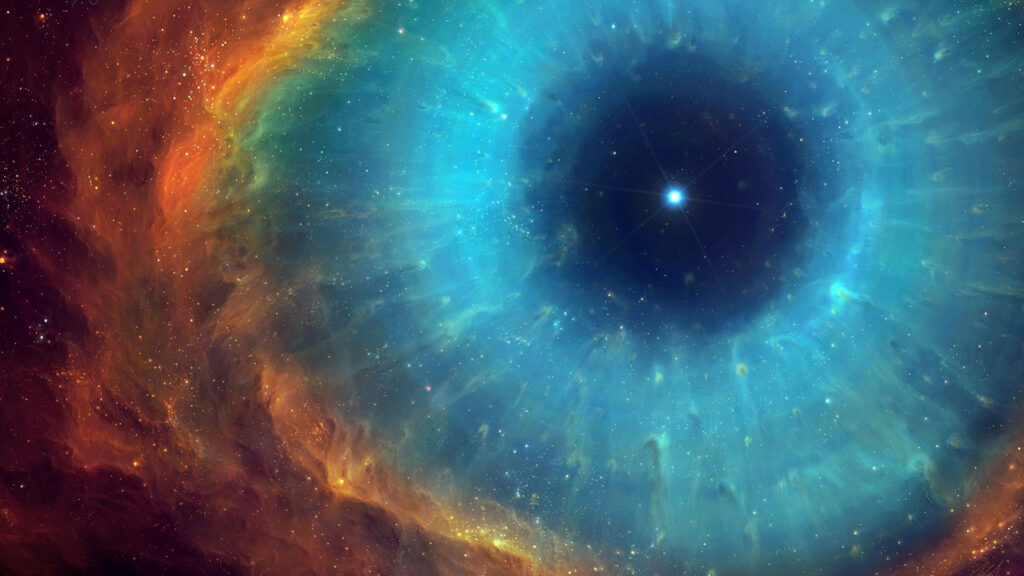 Jean Houston
Jean Houston
Like Meister Eckhart, “The eye by which I see God is the same eye by which God sees me.”
Joseph Campbell
The ultimate leave taking says that God is the leaving of God for God, leaving your historical idea of God for this transcendent … connotation.
And so, well there’s a lovely one of Hallaj, the Sufi mystic, where he says, “A moth at night sees a flame. This is the mystic beholding his God, and the flame is within a lantern. And this flame is seen through the glass and the moth batters itself on the glass trying to get through to the flame. Then when morning comes he goes back to his friends and says, ‘what a wonderful thing I saw last night’. It’s friends say, ‘you don’t look the better for it’. This is the condition of the ascetic, working, Vishuddha, to cleanse himself, you know? Well, the next night he goes back, and by chance the lantern hasn’t been well closed, he finds his way through and for an instant he achieves his aim, he IS the flame! Oh, wow. That’s the ultimate.
 Well, Hallaj was crucified, because he had said, what Jesus had said, “I and my beloved are one.” And as he was brought to be crucified, — I mean, it was 900 years later, but the same thing going on — as he was brought to be crucified, — because the Orthodox community has mistaken the denotation for the connotation [of the metaphor]. So God’s out there not in here. You and he are not one. there’s that separation and that line — he beholds, the cross, he sees the instruments of torture. And he is supposed to have said, “Oh Lord, if you had taught them, what you have taught me, they would not be doing this to me, if you had not taught me what you’ve taught me, they would not be doing this to me, praise the Lord in all His works.”
Well, Hallaj was crucified, because he had said, what Jesus had said, “I and my beloved are one.” And as he was brought to be crucified, — I mean, it was 900 years later, but the same thing going on — as he was brought to be crucified, — because the Orthodox community has mistaken the denotation for the connotation [of the metaphor]. So God’s out there not in here. You and he are not one. there’s that separation and that line — he beholds, the cross, he sees the instruments of torture. And he is supposed to have said, “Oh Lord, if you had taught them, what you have taught me, they would not be doing this to me, if you had not taught me what you’ve taught me, they would not be doing this to me, praise the Lord in all His works.”
And the saying is, the function of the Orthodox community is to give the mystic his desire, namely union with the Creator. So, you know your place now, whether you’re on the way or helping someone else on the way. Your point of view, depends on whether you know the difference between the connotation and denotation [of the metaphor].
So, then, we come down to this question of what happens when the screen is withdrawn. Here is the self, the Jiva beholding the Lord, Ishwara. And the barrier is withdrawn and nobody there. And so asks Carl Jung, “How does anybody know anything”, you see? Ramakrishna says, “A salt doll, wanted to measure the depth of the ocean, and it walks into the sea.” That’s the image.
 What can you do about that? What you can do about that is know that it’s there. Know that you and That are one. And I mean, the fact that time and space are the forms of sensibility, and these are what make us many, is the prime fact. Now there’s a wonderful passage in one of Schopenhauer’s fundamental essays called The Foundations of Morality, where he asked the question, how is it that one can so participate in the danger and peril of another, that forgetting one’s own self-protection, one moves spontaneously, not it’s my duty, not I ought to, but, BING! you go to that other’s rescue and [you] may be killed. What is it that makes it so happen, that the prime impulse of life, namely self-preservation, Chakra 1, is suddenly dispelled and another realization comes through? He says this is a metaphysical realization, this is the realization that the opening of the heart at Chakra 4, the realization that you and the other one, the separation is secondary, a function of the way we see things in time and space.
What can you do about that? What you can do about that is know that it’s there. Know that you and That are one. And I mean, the fact that time and space are the forms of sensibility, and these are what make us many, is the prime fact. Now there’s a wonderful passage in one of Schopenhauer’s fundamental essays called The Foundations of Morality, where he asked the question, how is it that one can so participate in the danger and peril of another, that forgetting one’s own self-protection, one moves spontaneously, not it’s my duty, not I ought to, but, BING! you go to that other’s rescue and [you] may be killed. What is it that makes it so happen, that the prime impulse of life, namely self-preservation, Chakra 1, is suddenly dispelled and another realization comes through? He says this is a metaphysical realization, this is the realization that the opening of the heart at Chakra 4, the realization that you and the other one, the separation is secondary, a function of the way we see things in time and space.
That’s the way to experience transcendence on the emotional level. There’s another way of realizing it. I once was lecturing to a group of prep school boys on Buddhism and you may say well, that’s not a very good audience, on the contrary, it’s a very good audience. And I came to the point of this ultimate bodhi or realization, of who and what you really are, the you that is not the you that you’re taking care of all the time. And I looked at the ceiling and an idea came to me, I said boys looked up.
You see the lights are on. You can say either, the light is on or the lights are on. These are two ways of saying exactly the same thing. In the latter case, you are accenting the individual bulbs. In the other, you’re speaking in terms of the total situation. In Japanese, this is called respectively jiyo kai (自界) and ryo kai (両界), the individual realm and the general realm. And then they say ji, ri, mu gai (自 両 無我); individual, general, no obstruction — these are the same.
And so I say, one day one of the bulbs dies, and the Superintendent of Buildings and Grounds comes in. And he doesn’t say, “That’s the bulb I appreciated. This was the one that really counted.” Nothing of the kind. He takes that one out, throws it away, and puts another bulb in. What’s important here? Is it the vehicle? Or is it the light?
 I look down at the boys’ heads and say, “and what’s important down here? And of what are these the vehicles?” They’re the vehicles of consciousness. Which is important, the vehicle or the consciousness? And which are you? Now that’s the big mystical experience. What do you identify with, this thing here, this temporal moment or with the consciousness, which informs it, and informs you of it. And if you can shift, and it can happen. If you can just shift and it can happen naturally, without any effort. And one thing I found out, the older you get, the easier it is to do all those things you were trying to do when you were a kid. Providing they’re such things as this. It happens automatically. Identify with the consciousness.
I look down at the boys’ heads and say, “and what’s important down here? And of what are these the vehicles?” They’re the vehicles of consciousness. Which is important, the vehicle or the consciousness? And which are you? Now that’s the big mystical experience. What do you identify with, this thing here, this temporal moment or with the consciousness, which informs it, and informs you of it. And if you can shift, and it can happen. If you can just shift and it can happen naturally, without any effort. And one thing I found out, the older you get, the easier it is to do all those things you were trying to do when you were a kid. Providing they’re such things as this. It happens automatically. Identify with the consciousness.
And when you have identified with the consciousness, you’ve identified with the consciousness in everybody else’s life. And then you can say, ji, ji, mu gai (自 自 無我); individual, individual, no obstruction. This is the awakening of the heart, in fact. And from then on, death is no problem. What dies is the body, it loses its energy, it loses its power, you can no longer intend the life course, you’re on the momentum of the one that you’ve established. But you can be grateful to the body and to the life that gave you this realization of your participation in consciousness. That’s the realization of the top. So with that little prelude, perhaps we could have the slides. And I think we can go through them now in a way that will be illuminating of the way in which mythic images transform according to the stage of consciousness you’re on.1
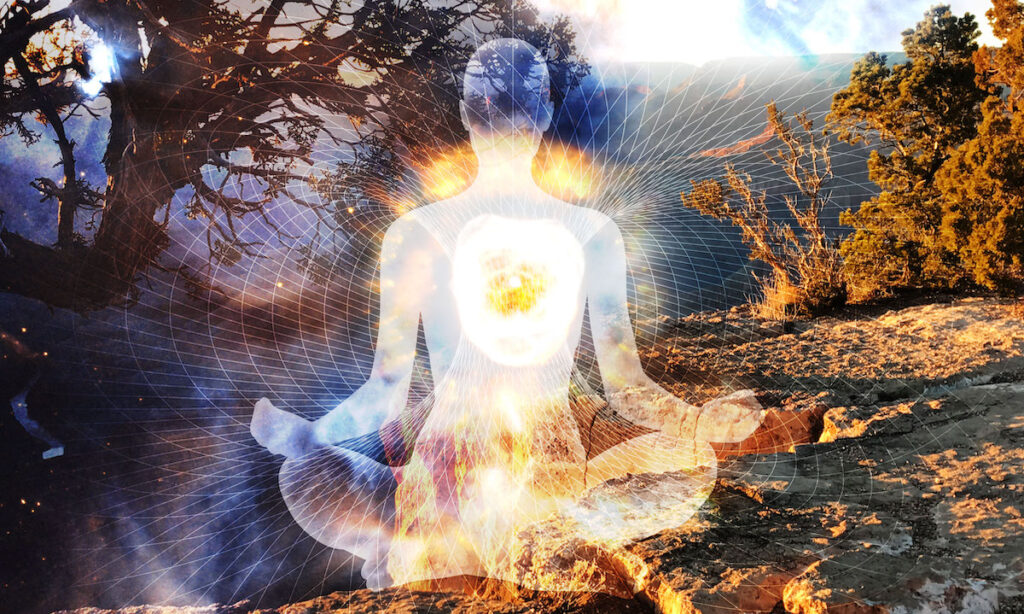
Footnote:
- 1 Jean Houston and Joseph Campbell, The Convergence of Existential and Archetypal Realities, Human Relations Institute, Santa Barbara, CA, October 1985
Resources:
- Also go to Chakras & Felt-Sense – 1 & 2
- Polyvagal Theory – Parts 1 to 5
- Resourcing: Meeting Life’s Challenges
Disclaimer:
The information featured on this site is provided for information and education purposes only and is not intended to replace the advice of your doctor or health care provider on medical and/or health-related issues.
You should not use the information on this site for diagnosis or treatment of any health problem or as a substitute for medication or other treatment prescribed by your physician or health care provider.

